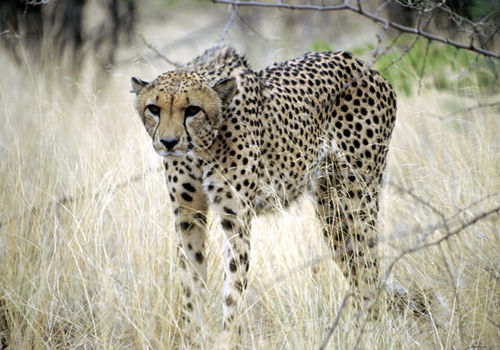
Cheetah
Acinonyx jubatusCheetah
Introduction: The cheetah (Acinonyx jubatus) is the fastest land mammal and can reach speeds of up to 105 km/h. As it can only keep this pace up for 300 - 400 metres, stalking their prey to a distance of around 50m is preferred before setting off on the chase. Males form coalitions whilst females remain solitary.
Cheetah are at home in either open grasslands or savannah woodland and often utilise the fringes of desert. Their occurrence is usually governed by availability of specific prey species. They are found in neither forest nor woodland with thick underbush or tall grass cover, although they will use these habitats for shelter. Water is not essential to their survival as they can survive on the moisture from their prey.
Distribution: Namibia is home to a large portion of the world's remaining cheetah population and anyone visiting the country should take the time to visit either the Okonjima Lodge or Okonjima Bush Camp to learn about the work been done by the Africat Foundation to protect and rehabilitate theses animals
Diet: The cheetah's main prey is medium to small antelope such as steenbok, duiker and springbok. Accounts of males grouping together to hunt larger prey such as wildebeest have been observed and they also chase baboons, ground-living birds, bustards, hares and porcupines.
Colouring: This cat is characterized by a beautiful strongly spotted coat and by a long tail which is half as long as the length of its head and body. The tail has a unique pattern of striped markings.
Breeding: Cheetahs do not have a fixed seasonal breeding cycle and in this respect, they are similar to leopards. Cubs are born after a gestation period of about 90 -95 days. Litters average three cubs, occasionally up to six, born in the shelter of tall grass or cunningly hidden in underbush. Cubs stay with their mother for about two years, but sadly, most of them never live to adulthood because they are preyed upon by lion, leopard, hyena, fox and eagles.
Being a comparatively frail cat, the mother often has to give up her young or risk being killed herself. However in areas where there is good cover or few predators, the possibility of a cheetah's survival is good.
Size: Cheetahs are around 2m from snout to the tip of the tail, with a body mass of between 40 – 60kg. They stand about 80cm at the shoulders, which is accentuated by an erect crest of hair.
Klein Windhoek

